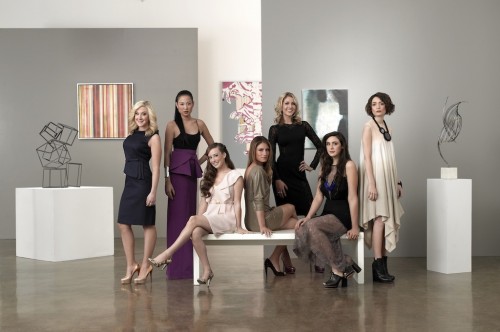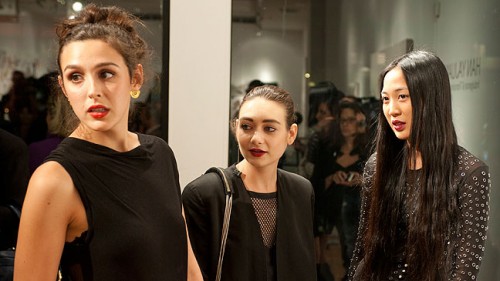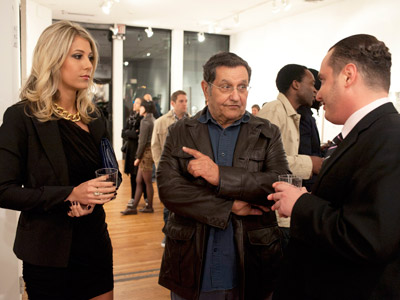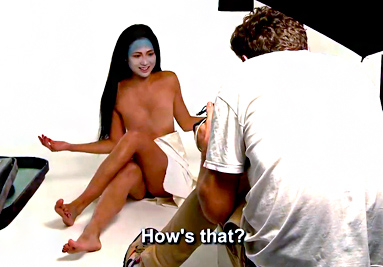WHAT TO SAY about Bravo’s new reality show Gallery Girls? You could go on about how unbearably awful it is, how selfish the women, how vapid the art world, but why? Isn’t that the point of reality TV? I can hear the pitch meeting now. Someone says, “Yes! It’s Real Housewives crossed with Girls and a dash of Sex And the City.” The latter was thrown in, no doubt, just in case Girls isn’t glamorous enough. (Though, just to say it has its own gallerina in Marnie and Lena Dunham grew up in the art world). Bravo has over the last couple years lit upon contemporary art with shows like Work of Art: The Next Great Artist where artists compete Top Chef-style for a show at the Brooklyn Museum and $100k. Yes, you read that right one hundred thousand dollars. And, what is there not to be fascinated with in the current art scene? It’s weird, monied, rarified and removed. There’s power, private jets and parties. Miami’s Art Basel, we are promised in the GG’s previews, will figure big. Trailers show characters from the show downing shots there as if at a frat party.
America, I worry you will think this is contemporary art or the art world like you once thought Sex and The City showed what it meant to be a single girl in NYC. It’s not. No “real” gallery was tortured in the making of this show. You won’t see Marian Goodman or David Zwirner or Larry Gagosian. Still, the art world is fascinating. It’s easy enough to look at a piece of conceptual art and think, They spent this outrageous sum on that?
The very notion of an “art world” makes it seem exotic, separate from the rest of us, like it’s a fortress or a foreign country – or like the fashion world – with its own rules and manners and mores, not to mention language. The art world though is a realm ruled by a dichotomy. On the one hand it caters to the rich (collectors) and is about cachet (dealers won’t just sell a piece to anyone who shows up with cash in hand but want established collectors who promise to give a piece to museums, say). Then there are the art fairs, parties and in-crowds. At the same time it wants to think it’s absolutely not about money at all, that it’s above commerce with a kind of Edith-Wharton propriety ruling everything. Part of conceptual art is criticizing these elements, the money, the institutions…, examining how they make meaning, so both are true at the same time. The art world is about money. It criticizes money. That schizo nature is part of what makes contemporary art interesting. You won’t get that with Gallery Girls. You will, however, see these girls-slash-women and be horrified, but they’re not in the art world. They’re not even real gallery girls.
Indeed working in galleries there are women (and men) with sleek hair and clicky-clacky high heels (though usually not on the blokes). They are often underpaid and their job (in part) is to man the front desk. Put any of them on screen, and they would look just as bad as these girls. Put me on screen and I would too. Hell, so would Gandhi talking about his homespun fabric. It’s all a trick of editing and scripted situations. But, here on the show we have interns (four of them) working for an art advisor and at a gallery that’s hard to take seriously, while another wants to be a photographer and two more run End of Century, a boutique-slash-gallery (which also breaks the art world’s rules of commerce and the service thereof). The one gallery on the show, Eli Klein, is in Soho, which long ago ceded its place in the art world. It migrated north and west to Chelsea in the 90s and more recently back south and east to Chinatown, the Bowery and the Lower East Side. Soho was abandoned to the likes of Chanel, Prada, Uniqlo – and, on West Broadway, Eli Klein.
So, who are these not gallery girls? And how did Bravo find them? Even as late as September last year just before shooting began, they were still looking for that elusive 6th girl. The production company sent out an email searching for “a gifted and vivacious trailblazer with a tell-it-like-it-is attitude. This gallery girl will inspire others with her wit and charm, but she should also be sly-as-a-fox when it comes to the politics of New York City’s art gallery world.” Corinna Kirsch wrote for The L Magazine about being approached for the show. She was told they’d recruited the other girls on Craigslist. Yes, Craigslist, and the producer said to her, “If I did agree to be on the show, I’d be set up with an internship at a gallery. I asked which ones, but the producer hadn’t nailed down any spaces yet. He did mention that he’d been scouting locations in the LES earlier that day. Several of the spaces asked him to leave when he suggested filming a TV show there.”
So, there you have it. Episode one sets out the show’s big theme: cool girls vs. rich girls and how their rivalries play out across the city. The idea being it’s all Upper East Side vs. Lower, Manhattan V. Brooklyn, as if boroughs and neighborhoods correspond to class. A flashing orange map shows us where we are at any one time. It’s an annoying interstitial about as ridiculous as the Instagram effects used between scenes.
Our cast includes Liz Margulies (whose father Marty Margulies is one of the most important US collectors and recently gave $5 million to the Met, which is working to beef up its contemporary art holdings) and Amy, who Liz has known since they were five. All the characters are reduced to quick descriptions: the rich mean girl (Liz), the partier/maybe alcoholic (her friend Amy. A web search reveals she sued Sotheby’s when they kicked her out of their Institute of Art ). There’s the hardworking middle class girl (Kerri Lisa) and the one who gets betrayed, the one who doesn’t stick up for herself, the sexually outrageous one and so on. It all feels concocted for the camera; even the boyfriends don’t seem real. (I find it funny how the rich Upper East Side girls have muscle-bound beaux, while the LES girls have skinny consumptives, and how they all seem to be at openings at which none of them would be caught dead). To be fair Bravo doesn’t call the show reality TV but a “docu-series” as if to get some leeway with the truth.
Despite the network’s best efforts I feel for these girls-slash-women. There’s Kerri Lisa – yes, first name as last name, and while people might not trust those with two first names, I like her. Her mom sounds like she’s out of a Dennis Lehane novel with her two-packs-a-day rasping voice, and we discover in Kerri’s first scene her parents have always held multiple jobs to make ends meet. Still, she calls herself middle class, and in that moment the American dream is writ large on my small (computer) screen. I want her to make it. She’s also understated. There’s the way she mentions her job as a personal concierge for the wealthy. She barely swallows the words and her voice doesn’t falter but with that look on her face I feel for her because that job is hell. She is normal or nearly, so far as I can tell. I worry for her being on the show.
Meanwhile, Lauren got her family to kick in $15k for the launch of the store / art gallery End Of Century. By most standards that’s not a lot of start-up money. It’s a fraction of what one of Liz’s dad’s lesser pieces would fetch, and Lauren’s business partners blithely ignore her fears about paying her parents back. The trailers show the situation coming to a crisis as she calls her parents in tears when the shop/ gallery gets a final shut-off notice for the electricity. I worry for her too. In fact, I worry for all of them – even rich bitch Liz.
In episode one it’s hard to find her humanity with her bright-blond-highlighted overconfidence and entitlement, but she’s trading on her father’s importance when she really wants his attention. Meanwhile he seems pretty down to earth, schlumpy even in jeans and a t-shirt. He gives the show a veneer of normalcy, and I wonder how she talked him into doing this? Did she plead that she just needed this, dad? Can you please just once do something for me? As she goes in for her interview at sleazy Eli’s gallery, you can feel the sweat oozing from his pores as he lusts for her father’s prestige. No doubt we’ll get more of her bad behavior but probably not much of her pathos. Previews show her partying down and drinking it up in her hometown at Art Basel Miami, but the filming corresponded with her dad’s divorce from her stepmother, who by all accounts (off the show) is level. She’s had no surgery; her hair is gray and her clothes diaphanous, giving her the look of an ageing Venus on the Half Shell. She also started a women’s homeless shelter. Its name Lotus House makes me think she’s Buddhist.
Then there’s Angela flashing her breasts for the camera early in the episode. She is a model wanting to be a photographer. This is what the show is really about: wanting to be, that longing when you’re on the cusp. On the cusp of what is unimportant just that need that’s so strong you can taste it. I want to take her in my arms and whisper that it’s okay, that you don’t have to expose yourself like that. Just because you can speak quickly and sound like it’s your choice… Just because people laugh and smile when you talk about your pussy or being photographed nude…. Watching her propensity to flirt and that power to shock, using her sexuality as armor, makes me feel like I’m seeing a Jean Rhys novel unfold. It also feels like a ghost of myself, when I could briskly declare that I was a stripper because stripping was so much more honest than the art world. Back when I was in grad school and the Whitney Program, I found the dichotomy inherent in the contemporary art scene staggering. But, there was also something about acting sexy and a display of intimacy. They kept me safe from having to expose myself by being real, or intimate, or vulnerable.
There is one other thing the show brings up: I was a gallery girl too. Unlike the girls on Bravo who were inspired by Sex and the City, I moved to New York with a fantasy of it being like the Eighties East Village scene – all Richard Kern movies and Lydia Lunch, post-punk bands and clubs where fashion and art, film and music rubbed up against each other, where it all felt essential. Of course, by the time I got there, that world was waning. After my freshman year of college I got a job at an art gallery I won’t name. I’m too ashamed to. It was second (at best) rate. It had the same Eli Klein vibe though the director has gone on to teach and run MA programs. I didn’t wear designer clothes but ones from thrift shops. And, I slept with my boss. I’d pushed this out of my mind until Gallery Girls landed on my desk. Then I looked him up online and just seeing his name, my breath goes shallow, my chest tight. This was more than 20 years ago, and there are all the things I know about sex and workplaces and power, and still I’m ashamed.
I can hardly bear to think about that summer. It was hot and sweaty; we hung a show; he slapped my ass. That night I stood next to his girlfriend at the opening. I remember my mother meeting him later in the autumn and saying how nice he was, that not all these people would be good, and by that she meant wouldn’t take advantage of her 19 year-old daughter. As she spoke, a bubble of guilt was trapped in my chest. This is the thing about Gallery Girls though, not just Angela but all of them: not all these people they meet will be good. This is what they trade with their longing that’s so palpable. These girls think they’re getting something, but they don’t necessarily see what they’re giving up – or that the exchange is uneven. They are girls on the cusp of being women. They are vulnerable no matter how brassy they sound. A friend of mine recently recalled her first job at a major magazine. She was in her early twenties. A girl in the art department slept with the editor-in-chief; other editors hit on my friend. It was so easy to think that in that exchange you were getting something, you were getting ahead. The girls on Gallery Girls might not be having sex, but they’re exposing themselves. It’s a time-honored practice. Two decades on, I think now about that boss and feel guilty, like it might have been my fault. I remember threatening to tell his girlfriend so he’d stop, just as I remember that humid night and the white wine I’d bought for the opening and standing between him and his girlfriend. A fizzy feeling of recent sex and confusion and disgust rose in my gut. The disgust and confusion were directed at myself.
Watching Gallery Girls, I think about how we eat our young. The girls, we turn them into fodder like leading virgins to a boiling pit. But, I was also complicit wasn’t I? That’s why my feelings were so complex, right? What will these six girls-as-women tell themselves twenty years from now?







I would say Chantal is more of a bitch than Liz. She openly snubs the UES girls. But yes, I’m worried for all of them!
Yes I think the Mean Girls’ behavior is a bit up for grabs. We could have a competition here on The Weeklings laying odds on who is most mean and who is the most hurt – and who gets the most mileage out of appearing on the show.
I worked for a miserable woman at a law firm for two years. In 40 years of working for difficult, rich bosses, I never worked for such a self-absorbed person who thought she was perfect. Liz makes my former employer look like Mother Theresa. I have seen some troubled obnoxious people on Bravo, but not one lacked a soul until Liz showed up. I hope she reads this. She once said she was a kind person. Not only is she obnoxious, she is a liar too.